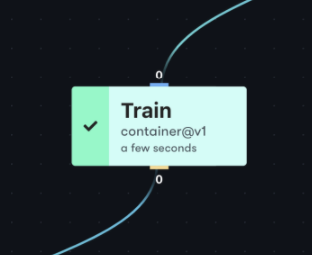Understanding Inputs & Outputs
This guide explains how to work with datasets, volumes, and strings.
Workflows are in beta, so try them out and let us know what you think. Hold off on using them for production use cases, as we can't promise bug fixes or new features just yet.
Overview
A Gradient Workflow is composed of a series of steps. These steps specify how to orchestrate computational tasks. Each step can communicate with other steps through what are known as inputs and outputs.

There are three types of inputs and outputs. Understanding how these function will help you craft concise and elegant Workflows.
- Datasets
- Volumes
- Strings
Datasets
The dataset type leverages the Gradient platform native dataset primitive. Information stored within datasets is not limited to any single type of data. In fact, a generic dataset can include anything from pretrained models to generated images to configuration files. Inherent to datasets is the notion of versions. Workflows can consume and produce new dataset versions as well as tag new versions of existing datasets.
Datasets must be defined in advance of being referenced in a workflow. See Create Datasets for the Workflow for more information.
Scenario 1: Consuming a dataset that already exists within Gradient
inputs:
my-dataset:
type: dataset
with:
ref: my-dataset-id
Scenario 2: Generating a new dataset version from a Workflow step
my-job:
uses: container@v1
with:
args:
- bash
- "-c"
- cp -R /my-trained-model /outputs/my-dataset
image: bash:5
outputs:
my-dataset:
type: dataset
with:
ref: my-dataset-id
my-dataset-id can be the actual ID of the dataset, a 15 character string that looks like def123ghi456jkl (or appended with a version ID too), or a name for the dataset.
Volumes
Unlike, e.g., GitHub Actions, it is likely that multiple Gradient Steps/Actions will execute on multiple compute nodes. To facilitate the passing of data between these nodes, Gradient Actions expose the notion of volumes and volume passing.
Volumes enable actions such as the git-checkout action. Volumes can be defined as input volumes or output volumes or both. When a volume is an output it is mounted in /outputs and is writeable. When a volume is an input it is mounted in /inputs and is read only.
Volumes are limited to 5GB of data currently. If you need more space we recommend using Datasets.
Here is how you would define an output volume:
outputs:
my-volume:
type: volume
In this example a volume is first created as an output and then used as an input in a subsequent job step:
defaults:
resources:
instance-type: P4000
jobs:
job1:
uses: container@v1
with:
args:
- bash
- -c
- echo hello > /outputs/my-volume/testfile1; echo "wrote testfile1 to volume"
image: bash
outputs:
my-volume:
type: volume
job2:
needs:
- job1
uses: container@v1
with:
args:
- bash
- -c
- cat /inputs/my-volume/testfile1
image: bash
inputs:
my-volume: job1.outputs.my-volume
Volumes cannot currently be used as an output after the job they were created with. This limitation is planned to be removed in the future.
Strings
In some cases, you may need to pass a single value between Workflow steps. The string type makes this possible.
Scenario 1: Passing a string as a Workflow-level input
inputs:
my-string:
type: string
with:
value: "my string value"
jobs:
job-1:
resources:
instance-type: P4000
uses: container@v1
with:
args:
- bash
- -c
- cat /inputs/my-string
image: bash:5
inputs:
my-string: workflow.inputs.my-string
Scenario 2: Passing a string between job steps
defaults:
resources:
instance-type: P4000
jobs:
job-1:
uses: container@v1
with:
args:
- bash
- -c
- echo "string output from job-1" > /outputs/my-string; echo job-1 finished
image: bash:5
outputs:
my-string:
type: string
job-2:
uses: container@v1
with:
args:
- bash
- -c
- cat /inputs/my-string
image: bash:5
needs:
- job-1
inputs:
my-string: job-1.outputs.my-string
Scenario 3: Creating a model from a dataset and passing the model ID as a string to a Deployment step
There is no native Gradient Actions for Model Deployments today. Instead, you can use the Gradient SDK to create and manage your inference endpoints.
To run this example you will need to
- a) create a dataset named
test-modeland upload valid TensorFlow model files to it - b) define a secret named
MY_API_KEYwith your gradient-cli api-key - c) substitute your
clusterIdin the deployment create step
defaults:
resources:
instance-type: P4000
jobs:
UploadModel:
uses: create-model@v1
with:
name: my-model
type: Tensorflow
inputs:
model:
type: dataset
with:
ref: test-model
outputs:
model-id:
type: string
DeployModel:
needs:
- UploadModel
inputs:
model-id: UploadModel.outputs.model-id
env:
PAPERSPACE_API_KEY: secret:MY_API_KEY
uses: container@v1
with:
command: bash
args:
- -c
- >-
gradient deployments create
--clusterId cl1234567
--deploymentType TFServing
--modelId $(cat inputs/model-id)
--name "Sample Deployment"
--machineType P4000
--imageUrl tensorflow/serving:latest-gpu
--instanceCount 1
image: paperspace/gradient-sdk